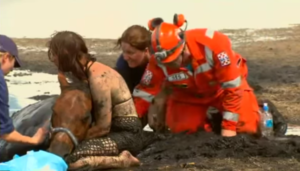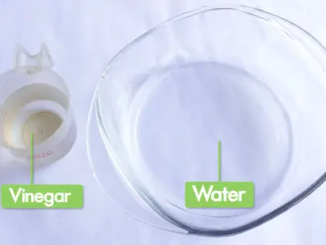Anyone who has been to the ocean knows how unpredictable it can be. One of the most dangerous things about the ocean is the tide. If you are in the wrong place at the wrong time, the tide can turn deadly.

The tide can rise quickly, swallowing people and animals in seconds. In some cases, it can lead to a slow and painful death. This is what nearly happened to an 18-year-old horse named Astro.
Astro’s owner, Nicole Graham, and her daughter were enjoying a ride on the beach near Geelong, south of Melbourne, Australia. But soon, the horses wandered into soft sand, which quickly turned into a muddy trap.

Nicole’s daughter and her horse managed to escape, but Nicole and Astro were not so lucky. They sank deeper into the mud, and Astro was soon stuck up to his neck in thick clay, in danger of choking. For the next three hours, Nicole stayed by Astro’s side, fighting to keep him alive.
As the minutes passed, the situation became more desperate. Nicole had to calm her 1,000-pound (450 kg) horse to prevent him from sinking even deeper into the mud. As the tide started to come in, Astro was getting closer to suffocating. He was also at risk of dying from dehydration and exhaustion.

Thankfully, Nicole’s daughter was able to get to safety and call for help. A rescue team and a veterinarian arrived on the scene. The vet gave Astro a sedative to keep him calm, while Nicole stayed by his side, talking to him to reassure him. The team even called a helicopter, but they couldn’t lift Astro because he was too deeply stuck in the mud for a rope to be tied around him.
The rescue team tried hard to free Astro, but the mud was like quicksand, making it almost impossible to dig him out. As the tide got closer, Nicole feared they wouldn’t be able to save her beloved horse.
Then, a farmer arrived with his tractor. In a last attempt to free Astro, they attached a rope to the tractor and pulled. That’s when the miracle happened. Together, Nicole, the rescue workers, and the farmer managed to pull Astro out of the mud.

You can watch the incredible rescue here:
Nicole, who owns 10 horses, often rides along the beach, but this was the first time one of her horses had gotten stuck.
Luckily, this story had a happy ending. But it shows the importance of being careful around the ocean, even in familiar places.
Most of all, this story is a beautiful example of the powerful bond between humans and animals. It shows that love and determination can make miracles happen!
Rare phenomenon: Sky turns blood red in China’s Zhoushan

The red sky that appeared in Zhoushan city of China’s east Zhejiang province was caused by the refraction and scattering of light, most likely from ship lights in the port, local media reported Sunday.
Over the weekend, residents of Zhoushan witnessed mysterious blood red skies, causing panic. Videos show the sky over the port city in crimson, largely owing to fog. The reports suggest that sky is perhaps the most red near the port areas.
Panic was palpable as people recorded the discolored horizon, stirring apocalyptic fears.

People recorded the skies turning crimson red, from their houses, balconies, and streets, Global Times reported.
The clips and photos of the phenomenon went viral with more than 150 million views on China’s Twitter-like social media, Weibo and Sina, Global Times reported. On Douyin, China’s version of TikTok, some users have called the phenomenon a “bad omen” due to how Chinese government is handling COVID-19 pandemic.

“I have never seen anything like this before. It really amazes me that the sky can even turn red,” a social media user said, as reported by Global Times.
“When weather conditions are good, more water in the atmosphere forms aerosols which refract and scatter the light of fishing boats and create the red sky seen by the public,” said reports referring to the meteorological bureau in Zhoushan.



Leave a Reply